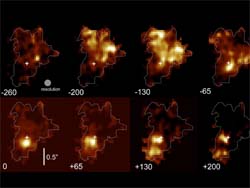
Velocity maps of Hα emission in BzK-15504
An international consortium of astronomers, including a CAS astrophysicist, has revealed how galaxies looked like in the Universe's early days. They discovered that massive galaxies already existed when the Universe is one fifth of its current age, posing challenges to the widely accepted hierarchical model of galaxy formation.
Together with his co-workers from Germany, Italy, US, Israel and Japan, KONG Xu from the Center of Astrophysics at the CAS-affiliated University of Science and Technology of China (USTC) obtained the most detailed glimpses so far of the formation of a galaxy similar to our own Milky Way. The work was reported in the August 17 issue of
Nature.
Scientists generally assume that the Universe was born from the Big Bang some 13.7 billion years ago, but they are not clear how and when the early galaxies were formed. A most widely accepted theory of galactic formation, called the hierarchical theory of galaxy formation, says that galaxies formed from "collisions" of smaller structures, which is a long process that could evolved over the past 8-11 billion years into the galaxies we see today.
By combining state-of-the-art adaptive optics techniques with the new SINFONI spectrograph on the Very Large Telescope at the European Southern Observatory, Kong and his colleagues found the rapid formation of a large rotating disk galaxy after the birth of the Universe. Their observation is not in accord with the hierarchical model.
They found a giant spiral galaxy, with a size and mass similar to that of the Milky Way, three billion years after the Big Bang. Known as BzK-15504, the luminous, star-forming galaxy has many similarities to present-day spiral galaxies, with rotational properties that are nearly identical to those of the Milky Way. These similarities are notable because they imply that at least some large disk galaxies were broadly in place even at these early cosmic epochs.
The work also provides immediate evidence to the presence of numerous massive galaxies in the early cosmic epoch, says Kong. No trace has been found for the mergers inside the galaxies, indicating the merging process was not the only approach for the formation of massive galaxies.
Also according to Kong, the possible scenarios for an early galaxy's birth and development may be depicted like this: under gravity, the interstellar molecular cloud undergoes a series of evolutionary processes of contraction and densification and finally leads to a collapse, resulting in the birth of a new spherical galaxy. Then a large and massive rotating protodisk is channeling gas towards a growing central stellar bulge hosting an accreting massive black hole. Within three billion years, it grows into a "mammoth lump" in the universe through "gulping down" a great amount of neighboring masses.





